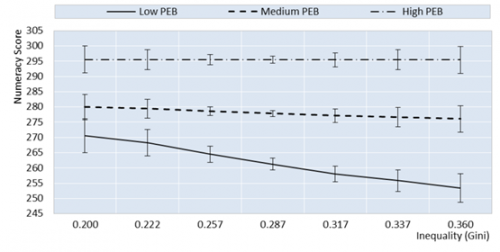Is inequality good or bad for growth?
Some level of inequality might be necessary in a modern economy, but new research indicates that income inequality has curbed growth significantly. Sergio Arzeni from the OECD in Paris says it’s vital to understand how this impacts our societies and economies.
If you’ve been following the income inequality debate, you’ll know there’s been much discussion of the question in the headline above. Until just a few years ago, it’s probably fair to say that mainstream opinion leaned towards the “good for growth” side of the debate. Yes, inequality might leave a bad taste in the mouth, but it was worth it if it meant a strong economy.
This case rests on three main arguments: First, inequality creates incentives for entrepreneurs. Second, wealthy types are a source of investment for the economy. Third, when the state tries to reduce inequality by taxing wealth and transferring it to the less well-off, some of these resources will be lost in the “leaky bucket” of bureaucracy and administration. From an economic perspective, that’s inefficient.
All these arguments have some merit, and indeed few would disagree with the idea that some level of inequality is necessary in a modern economy. But over the past couple of years, the bigger proposition – that inequality is good, or at least not bad, for growth – has come under increasing fire, including from the IMF, the OECD and even Standard & Poor’s. And now comes new research from the OECD indicating that “income inequality has curbed economic growth significantly”.
Much of the coverage of rising inequality has focused on the incomes of “the 1%”. But the OECD research, which was led by Michael Förster and Federico Cingano, indicates that it’s the situation of people at the other end of the earnings scale that has the biggest impact on growth. These lower-income households are not a small group. They represent some 40% of the population, comprising families that, from a social perspective, might be called lower-middle and working class.
Where overall inequality is higher in a society, a clear pattern emerges: People from such backgrounds invest much less in developing their human capital – essentially their education and skills. By contrast, it has almost no impact on the educational investment of middle-income and wealthy families. The implications for social mobility are clear – an ever-widening education and earnings gap between society’s haves and have-nots.
This gap is seen not just in the length of time people spend in education but also in their skill levels. At the risk of swamping you in data, this is strikingly evident in the chart below. It divides the overall population into three groups based on parental education background, or PEB (which is used to represent socioeconomic status) – high, medium and low levels of education. The chart then looks at the average numeracy scores of people from each of these three groups in the OECD’s Adult Skills Survey and charts them against levels of inequality as measured by the Gini coefficient (where 0 equals absolute equality and 1 equals absolute inequality).

Where inequality is relatively low (around 0.20), the gap in numeracy levels between the three groups is relatively modest. But, on the other end of the scale, where inequality is higher (around 0.36 – a little more than in the UK today and a little less than in the US), the score of people from poorer backgrounds is markedly lower; by contrast, the scores of people from middle and high-income families don’t change much.
How does this affect growth? As an economist might say, it’s “inefficient” – workers with higher skill levels can contribute more to the economy. If a large swathe of the population is unable to invest in its skills, that’s bad news for the economy.
Just how bad is clear from the OECD research. It estimates that rising inequality knocked more than 10 percentage points off growth in Mexico and New Zealand in the two decades up to the Great Recession. The impact of rising inequality was also felt – albeit not as strongly – in a number of other OECD countries, including Italy, the UK and the US and even in countries with relatively low levels of inequality like Sweden, Finland and Norway
To be sure, the debate over inequality and growth will certainly continue. Just before publication of the new OECD paper, Nobel laureate Paul Krugman admitted he was a “skeptic” who remained to be convinced of the link. But the fact that the debate is happening at all is surely a good thing. Rising inequality is one of the most significant socioeconomic trends of our time. Understanding its possible impact on our societies and economies has surely never been more important.
Useful links
OECD work on income inequality and poverty
Focus on Inequality and Growth (OECD, 9 Dec. 2014)
Trends in Income Inequality and its Impact on Economic Growth (OECD Working Paper, 2014)
Dr Sergio Arzeni is the Director of the OECD Centre for Entrepreneurship, Small and Medium-sized Enterprises (SMEs) and Local Development. The Centre oversees the work of the Local Economic and Employment Development programme (LEED), the Working Party on SMEs and Entrepreneurship, the Tourism Committee, and the OECD LEED Trento Centre for Local Development (Italy). Dr Arzeni has worked at the OECD for over 20 years. Prior to joining the OECD, Dr Arzeni served as an economist for the Italian Parliament, the Italian Trade Unions and the European Commission. As an economic journalist he has contributed to several Italian and international newspapers. He holds a First Class Honours Degree in Political Science from the University of Rome and specialised in Industrial Economics at the International University Institute of Luxembourg and in International Economic Relations at the Brookings Institution in Washington DC, USA. He speaks French, Spanish, English, German and Italian.














